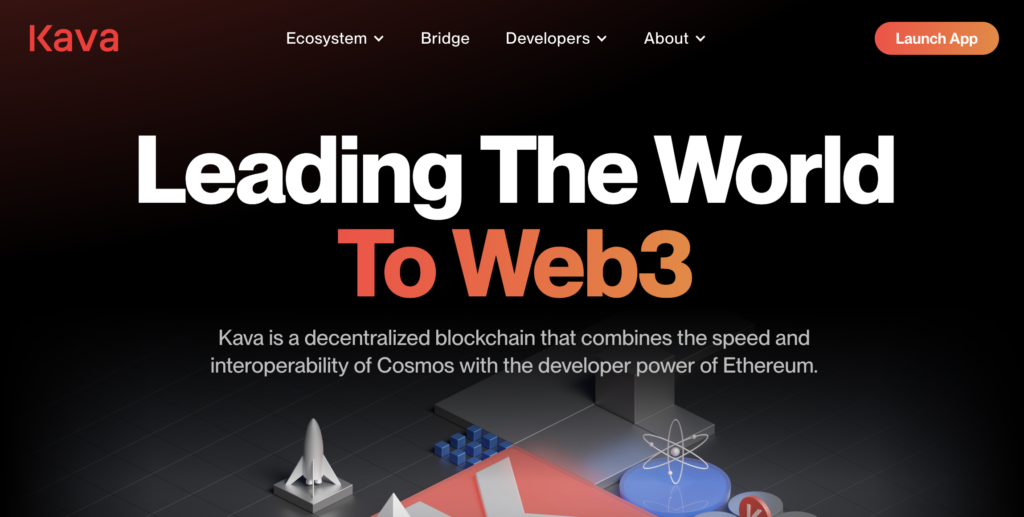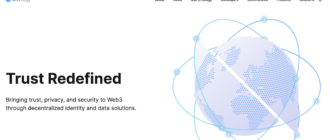The Kava project stands out as a significant player in the blockchain ecosystem, primarily focusing on providing decentralized financial services. It introduces a unique blend of offering a blockchain platform that integrates with multiple other cryptocurrencies, enhancing interoperability and creating a more connected crypto environment.

History of the Project
Kava was launched to fill the gap in decentralized finance (DeFi) by providing a robust platform for users to lend, borrow, and earn with crypto assets. Its development team comprises industry veterans who have contributed to the success of notable blockchain projects. Key milestones include its successful ICO, continuous updates to its protocol to support a wider range of crypto assets, and partnerships with major blockchain networks.
What is Kava
Kava is a blockchain project aimed at enhancing DeFi applications by using a co-chain architecture. This setup allows it to operate both as a native blockchain and as a component within other blockchain ecosystems, primarily focusing on security, scalability, and interoperability. It aims to solve issues related to the fragmented nature of financial services across different blockchain networks.
How the Kava Project Works
Blockchain Structure
Kava is built on a proprietary blockchain framework known as the Kava Platform, which utilizes a unique co-chain architecture. This design comprises two main chains: one for Ethereum compatibility and another for Cosmos SDK compatibility. This dual-chain approach allows Kava to seamlessly integrate with both Ethereum-based and Cosmos-based applications, leveraging the strengths of each ecosystem to enhance performance and usability. The Ethereum co-chain is optimized for Ethereum Virtual Machine (EVM) compatibility, enabling developers to deploy Ethereum-based applications and smart contracts directly on Kava. Conversely, the Cosmos co-chain utilizes the Cosmos SDK’s modularity and interoperability features, facilitating smoother cross-chain transactions.
Consensus Mechanism
Kava employs the Tendermint consensus protocol, a variation of Proof of Stake (PoS) known for its robust security features and high-performance transaction processing. Tendermint allows for quick finality of transactions, meaning that transactions are considered finalized as soon as a block is created, which typically occurs in a few seconds. This eliminates the risk of double-spending without the need for numerous confirmations typical in many other blockchain networks. Within this framework, validators play a critical role. They are selected based on the amount of KAVA tokens they stake as collateral. In exchange for securing the network and processing transactions, validators receive staking rewards. This staking mechanism also incorporates a delegation system, where token holders who do not wish to become validators can still participate in the network’s security by delegating their stakes to trusted validators, earning a portion of the rewards in return.
Unique Technological Features
Kava stands apart from other blockchain projects with its innovative integration of multiple consensus layers and its robust cross-chain communication facilitated by the Inter-Blockchain Communication (IBC) protocol. IBC enables the Kava blockchain to transfer information and value between disparate blockchains, which is crucial for achieving true interoperability in the DeFi sector. Additionally, Kava has introduced a modular framework that allows developers to launch custom blockchain applications that can interact with the core Kava platform while maintaining a high degree of customization and control over their environments.
Technical Innovations
Kava’s risk management protocol is another distinctive feature. It dynamically adjusts system parameters such as collateralization ratios and interest rates based on real-time market data and internal risk assessments. This proactive approach to risk management helps maintain the overall stability and reliability of the platform, ensuring that it can respond effectively to market volatility and other external factors.
In conclusion, Kava’s technology stack is designed not only to support robust decentralized financial applications but also to ensure that these applications can operate across various blockchain ecosystems efficiently. This cross-chain operability, combined with a strong emphasis on security and user-centric features, sets Kava apart in the crowded field of DeFi platforms.
Tokenomics of the Kava Project
KAVA: Token or Coin?
KAVA is classified as a token, not a coin, because it operates on the Kava blockchain specifically designed to support the broader Kava DeFi ecosystem. Unlike standalone cryptocurrencies or coins that are typically used merely as a medium of exchange within their own independent blockchains, KAVA tokens are used to facilitate various functions such as governance, staking, and fee payment within the Kava platform.
Emission Model and Distribution
KAVA’s emission model is capped, which means there is a finite supply of tokens that will ever be available, set at 250 million KAVA. This limit is designed to introduce scarcity, helping to manage inflation and encourage appreciation of token value over time. The initial distribution of KAVA tokens was conducted through a public sale, which helped to distribute tokens widely and ensure a decentralized stakeholder base. The emission of new tokens is governed by predefined rules within the Kava blockchain protocol, which gradually release tokens to support network operations, reward validators, and fund ongoing development.
Governance and Staking Mechanisms
KAVA token holders have the right to participate in governance decisions, including proposals to change technical features, economic parameters, and new integrations within the platform. This governance process is critical for ensuring that the platform remains aligned with the needs and interests of its users. For staking, KAVA tokens can be locked in the network to support the consensus mechanism. Stakers not only help secure the network but also earn rewards derived from transaction fees and the inflationary emission of new KAVA tokens. This staking reward system incentivizes long-term holding and active participation in network governance.
Utility and Fee Structure
KAVA tokens are used to pay transaction fees on the platform, which are set to be minimal to encourage usage and accessibility. The fees are used to compensate validators and delegators for their role in maintaining network security. Additionally, KAVA serves as a safety mechanism within the Kava lending platform; in the event of collateral liquidation, KAVA is used to purchase and burn the corresponding debt, helping to stabilize the platform’s overall economy.
Price Dynamics
The price of KAVA is subject to market conditions, influenced by factors such as adoption rates, overall crypto market trends, and developments within the Kava ecosystem. Price volatility is managed through a combination of token scarcity, utility within a growing DeFi platform, and active community engagement in governance, which together help drive demand and stabilize the token’s value over time.
In summary, the tokenomics of KAVA are designed to support a robust DeFi ecosystem through mechanisms that encourage active participation, reward contributions, and ensure platform stability. The capped supply, combined with multifaceted utility and a community-driven governance model, positions KAVA as a valuable asset within the Kava platform and the broader crypto economy.
Where to Buy KAVA Token?
KAVA tokens are available for purchase on several prominent cryptocurrency exchanges, ensuring accessibility for a global audience. The platforms where KAVA can be traded include:
- Binance: As one of the largest and most popular cryptocurrency exchanges globally, Binance offers extensive trading pairs for KAVA, including against major cryptocurrencies and fiat currencies, providing flexibility for traders.
- HTX (formerly Huobi): Known for its robust platform and security features, HTX provides another reliable option for purchasing KAVA tokens, with support for various trading strategies and tools.
- MEXC: This exchange is favored for its user-friendly interface and strong customer support, making it a good choice for both beginners and experienced traders looking to acquire KAVA.
- Bybit: Bybit is known for derivatives trading but also offers spot trading for cryptocurrencies like KAVA, appealing to those looking for an exchange that supports various types of trading activities.
- KuCoin: With a wide range of cryptocurrencies available, KuCoin is a popular choice among traders looking to explore different digital assets, including KAVA.
- Bitfinex: This exchange is well-regarded for its advanced trading features and liquidity, suitable for more experienced traders interested in buying and trading KAVA.
Each of these exchanges provides different interfaces, trading fee structures, and security measures, so users should choose based on their trading preferences and security considerations.
Where to Store KAVA Token?
For storing KAVA tokens, several wallet options cater to different needs in terms of security, accessibility, and functionality:
- Ledger Nano S/X: These hardware wallets are among the safest options available. They store tokens offline, providing protection against online threats. Ledger supports KAVA, allowing users to manage their tokens with the security of cold storage.
- Trust Wallet: As a mobile wallet, Trust Wallet offers a convenient way to store KAVA tokens directly on your smartphone. It supports a wide range of cryptocurrencies and features an easy-to-use interface, making it ideal for everyday use.
- Cosmostation: This wallet is tailored for tokens built on the Cosmos network, such as KAVA. It supports both web and mobile applications, providing flexible access to your tokens. Cosmostation allows for staking and participating in governance directly through the wallet.
- Atomic Wallet: A desktop and mobile wallet that supports multiple cryptocurrencies including KAVA. Atomic Wallet provides an intuitive interface and built-in exchange features that facilitate easy management and trading of assets.
Each storage option offers a blend of security features and user convenience. Hardware wallets like Ledger provide the highest security level by keeping tokens offline. In contrast, mobile and web wallets such as Trust Wallet and Cosmostation offer greater accessibility and practical features like direct staking and governance participation, which are beneficial for active users in the Kava ecosystem. Users should consider their specific needs, such as security, ease of use, and additional functionalities when choosing the appropriate wallet to store their KAVA tokens.
Future Prospects and Development Forecast
Growth Drivers
The growth of the Kava project is primarily driven by its innovative approach to combining the benefits of two major blockchain ecosystems: Ethereum and Cosmos. This unique dual-chain architecture enhances interoperability, making Kava an attractive platform for developers looking to create complex DeFi applications. Another significant growth driver is its commitment to scalability and security, which ensures that the platform can handle increasing transaction volumes without compromising performance.
Clients and Partners
Kava’s client base includes individual DeFi users, institutional investors, and blockchain developers interested in leveraging a robust and versatile platform for creating and managing decentralized applications. The project has also established strategic partnerships with major players in the blockchain and financial sectors. Some notable partners include:
- Chainlink: Integrates its oracle services to provide real-time data for Kava’s financial applications.
- Ripple: Works with Kava to explore new DeFi applications that can operate on both the Kava and XRP ecosystems.
- Binance: Supports Kava on its exchange and collaborates on developing new financial products that utilize Kava’s platform.
These partnerships not only expand Kava’s reach and capabilities but also enhance its credibility and visibility in the competitive DeFi market.
Development Forecast
Looking ahead, Kava is positioned to continue its expansion within the DeFi sector, with plans to integrate additional blockchains and increase the diversity of financial products available on its platform. The ongoing development of the Kava ecosystem aims to streamline user experiences and provide more efficient services, which are expected to attract a larger user base and stimulate further growth of the KAVA token’s value.
Ecosystem and Components
The Kava ecosystem is composed of several key components that collectively support its mission to become a leading DeFi platform:
- Kava Mint: Enables users to collateralize assets and mint stablecoins, providing a foundational service for DeFi activities.
- Kava Swap: A liquidity hub that allows for the swapping of assets across different blockchains, facilitating seamless asset transfers and broader market participation.
- Kava Lend: Provides decentralized lending services, giving users access to capital without the need for traditional credit checks or financial intermediaries.
- Kava Governance: Empowers token holders with the ability to vote on proposals and guide the development of the Kava platform, ensuring it remains responsive to community needs.
By continuing to develop and enhance these components, Kava not only broadens its service offerings but also strengthens its ecosystem, making it more attractive for users and developers. The focus on creating a seamless and interconnected DeFi environment is likely to remain a key factor in Kava’s ongoing success and influence in the blockchain space.
Conclusion
Kava represents a formidable endeavor in the blockchain space, aiming to bridge the functionality of various crypto assets through its innovative platform. For advanced users and investors looking into the strategic potential and technological backbone of blockchain projects, Kava offers a promising mix of technical robustness and forward-thinking in the rapidly evolving landscape of decentralized finance. Its ongoing developments and the expanding scope of its ecosystem make it a project worth watching in the DeFi domain.






